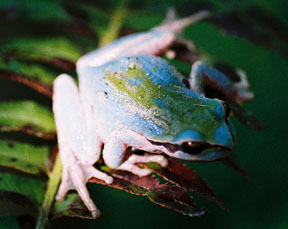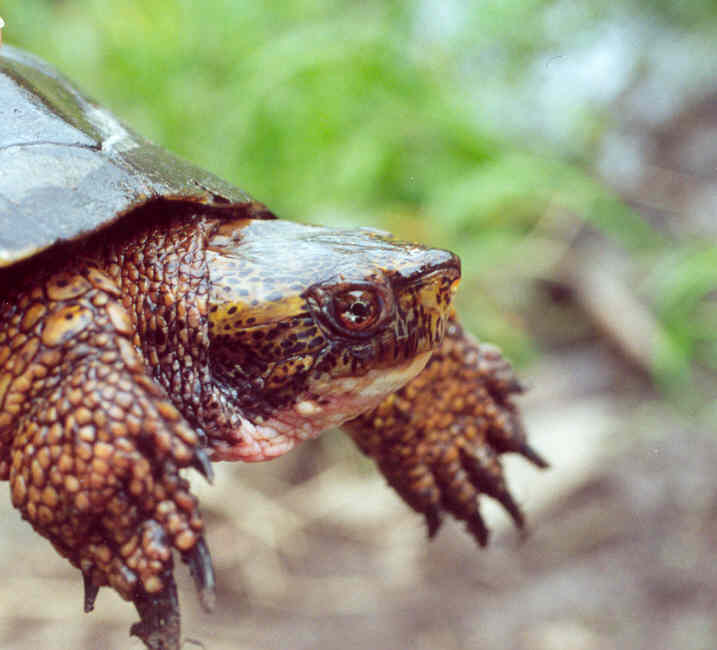
West Linn, Oregon
PHONE 503-638-5945
FAX 503-638-8047
9am to 5pm 7 Days a Week
(Closed Sundays in November, December, January, February)
Gardens
for Birds
 |
|
23311 SW Bosky Dell Ln. West Linn, Oregon PHONE 503-638-5945 FAX 503-638-8047 9am to 5pm 7 Days a Week (Closed Sundays in November, December, January, February) |
| Home |
| Photo Gallery |
| Greeting Cards |
| About Us |
| Plant Lists |
|
Hummingbird Gardens |
|
Gardening for Birds |
| Butterfly Gardens |
| Erosion Control |
| Lewis and Clark |
| Fundraisers |
| handouts |
| Websites |
| Native Plant Recipes |
| Judy Bluehorse |
| Guestbook |
| Mailing List |
| Employment Opportunities |
| Field's Creek |
| Reptiles and Amphibians |

|
Who is that croaking? If you're in the Pacific Northwest, most likely its a Pacific Treefrog. Also called "chorus" frogs for the symphony of song they produce on spring nights, Hyla regilla sing over a longer period of spring than their larger and quieter counterparts. The males are calling mates and defining territory. According to the field guide "Amphibians of Oregon, Washington and British Columbia" by Corkran and Thoms, "...one male acts as chorus master, leading the others to begin calling. Recordings of Pacific Treefrogs are used in jungle scenes in scores of Hollywood movies." Non-native Bullfrogs, on the other hand, vocalize mostly when they hop away from danger into the water, and native (endangered) Red-legged Frogs make noise only during the breeding season, and then under water.


The eggs of the Pacific Treefrog are usually laid from February through early May. They are encased in a sac, attached to vegetation, so include aquatic plants in your pond if you want to provide habitat that will support frog eggs (and oxygenate your water too!). Frogs also like to attach their eggs to sticks; include those in your water feature. The tadpoles also need plants to hide in; they have adhesive glands on their sides that stick to vegetation. Remember that the small non-native fish called gambusia (known by some as "mosquito fish") that people often stock their ponds with for mosquito control actually eat eggs and larvae of native amphibians. Do not add these fish to your pond - the frogs will take care of the mosquitoes!
Aquatic plants for your pond may include sedges, rushes, cattail, or wapato. Your choices will depend on the size of your water feature and your personal preferences. For more information, see our riparian page.
The Pacific Treefrog, Oregon's most common and smallest frog, is also the most varied in color. They are terrestrial, staying moist with glands on their skin that make a waxy coating. Provide a suitable woodland habitat for adults - shady, cool spots with lots of plants and debris (rock piles, branches) to hide in - and the adults will reward you by hanging around and eating your garden pests. Treefrogs are about the size of your thumb. They are abundant in healthy ecosystems here, and likely to be found in backyards if you are near a natural area with a river or creek, and especially if you have a pond for the frogs to lay their eggs in.
Red-legged beauties live here! Bosky Dell Natives is fortunate to also support a population of Red-legged Frogs (Rana aurora). These beautiful rusty red frogs with bright red coloring on their legs' undersides are much less common, and more secretive, than Treefrogs. They are much larger and require 50 to 100 acres of healthy habitat to thrive.
Invaders!!!!! The Bullfrog, that large hungry easterner, hopped west in the 1920s or 30s. Well, actually, Rana catesbeiana was helped by a few folks who considered their meaty legs good eats. Since then, being larger than our natives and with few predators to keep their numbers in check, they have out-competed, displaced and, yes, eaten, many native amphibians (not to mention the turtle hatchlings, ducklings and other birds they are purported to have dined on). They favor warm sunny ponds with many plants and marshes at low elevations, and may go hunting in temporary ponds as well. The very small eggs are laid in a broad sheet of jelly on the water surface in late May through earlly July, then slump onto aquatic vegetation before hatching. Tadpoles live in warm shallows with dense aquatic vegetation, and metamorphose after about two years.
Control Bullfrog populations by removing egg masses. Native frogs typically mate and lay eggs from late January through early May, whereas Bullfrogs do so from mid-late May through early July. If you go looking in early June through July, any frog eggs you find are likely to be those of our unwelcome guest!
Oregon's native turtles are, like the Red-legged Frog, in danger of disappearing. The Western Pond and Painted Turtles are freshwater aquatic turtles that inhabitat ponds and streams, various types of wetlands, and occasionally are seen along the rivers in Oregon at certain times of the year. As adults they reach 8-10" in length, and may live as long as 30-40 years.

Being reptiles, both species of turtles can be seen basking on sunny days; this important behavior is crucial in order for them to properly digest their food, carry out development of eggs, and other necessary life requirements. These turtles eat a varied diet, including fish, snails, aquatic insects, certain plants, and other matter. Both species lay their eggs on land, and the females look for open, sunny, sparsely vegetated areas to nest in order for the sun to incubate the eggs. When they leave the nest, hatchlings are only the size of a quarter, but are fully ready to take care of themselves as there is no parental care of the young. Both species hibernate in the winter from late October to early spring.

Both of our native turtles were once common in Oregon, but due to habitat loss, introduced predators such as bullfrogs and bass, and other factors, populations are declining in many parts of the state. Both species are listed by the State of Oregon as Sensitive Critical, a listing that implies their populations are in jeaporday and may warrant changing their status to threatened or endangered in the future. Our native turtles are protected by Oregon law and cannot be taken as pets.
People can help native turtles by protecting and enhancing habitats on their lands. Maintaining a diverse mix of forest, wetlands and open meadows will benefit turtles and many other species as well, including native frogs and songbirds. If you see a turtle crossing a road, slow down, pull to the side of the road and watch the turtle to make sure it gets across safely.
Call The Pacific Northwest Turtle Project at 503-330-0220 for turtle questions or if you find a sick or injured turtle.
Go organic to create and maintain a healthy backyard habitat. All amphibians are very sensitive to pesticides and herbicides. If you want to provide them a home, it is essential to garden organically. If you maintain a healthy, diverse garden the birds and amphibians will eat lots of bugs.
Many thanks to Sue Beilke, the director of the local Biodiversity Project of Tigard, for her time and willingness to share her expertise on local amphibians and reptiles. Much of the material here was taken directly from her. Thanks also to Jane Hartline for the egg pictures, and Sue Beilke for the frog and turtle pictures.
Reference cited: Amphibians of Oregon, Washington and British Columbia: Corkran, Charlotte C. and Thoms, Chris, Lone Pine Publishing, Vancouver, British Columbia, 1996.